
A sewer gas destructor lamp is a type of lamp used to remove sewer gases and their hazards.

A sewer gas destructor lamp is a type of lamp used to remove sewer gases and their hazards.
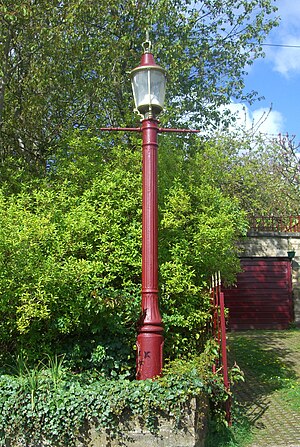
Biogas forming in sewers via anaerobic digestion can be a potentially foul-smelling and explosive hazard (chiefly due to chemical spills).[ citation needed ] Unlike ordinary gas lamps for street lighting, the main purpose of sewer gas destructor lamps is to remove sewer gases and their hazards. Joseph Edmund Webb of Birmingham patented a sewer gas destructor lamp.
Many of these lamps were installed in the UK in towns and cities including Sheffield, Winchester, Durham, Whitley Bay, Monkseaton and Blyth, Northumberland. [1] With a flame generated by burning town gas, sewer gases were drawn from the sewer below and discharged above the heads of passers-by to dissipate odours. The flame in the lamp does not actually generate sufficient thermal energy to combust any of the odour compounds in the air.[ dubious ]
JE Webb addressed a number of problems with the lamps with further patents. His patent GB189408193, [2] approved 2 March 1895, stated:
It has also been found that when the gases are drawn out from the sewer by the burning of ordinary gas a sudden flushing of the sewer might prevent any sewer gas from escaping, and thus momentarily cause the gas jets to be extinguished.
In order to solve this problem the patent specifies an arrangement of burners, air supply and heat reflection designed to produce an intense heat at the point of combustion–Webb suggests 600 to 800 °F (316 to 427 °C).
The lamps were installed at places where sewer gases were likely to collect, such as at the tops of hills. The city of Sheffield, being a hilly area, had many sewer gas destructor lamps and many remain.
Sheffield on the Net has a section on the old gas lamps, which states:
Eighty-four of these street lamps were erected in Sheffield between 1914 and 1935, the largest number in any British town, due mainly to the many hills in the area where gas could be trapped. [3]
The Sheffield Star newspaper reported a local survey of the lamps by W Jessop. [4] This survey found 24 remaining lamps in Sheffield. Twenty of these are grade II listed. In 2016 Sheffield residents campaigned for the lamps to be restored when the city council's replacement of every lamppost began, as part of the 25-year Streets Ahead road improvement programme. Sheffield Council plans to repaint the lamps and convert them to solar power with LED lights to replicate the original lighting. Sheffield's four gas-powered lamps will remain so after their restoration. It is planned that the lamps will be restored by December 2017. [5]

Only one working sewer gas destructor lamp remains in London; however, due to a traffic accident, the original lamp was damaged and has been replaced with a replica. This lamp is currently in use and can be found burning day and night down the side street of the Savoy Hotel in London. The story of this lamp has given rise to locals referring to Carting Lane as 'Farting Lane'. [6] [7]
Although many of the existing lamps in Sheffield and elsewhere are now disused, the lamps still have a use today in reducing odours. They do not prevent explosions as the concentration of methane in sewer gas is below the lower explosion limit (LEL) for methane.[ citation needed ] If the methane concentration were over the explosive limit (≈ 50,000 ppmv) the open flames in the lamps would burn like flares.[ citation needed ]

A Bunsen burner, named after Robert Bunsen, is a kind of ambient air gas burner used as laboratory equipment; it produces a single open gas flame, and is used for heating, sterilization, and combustion.

The Davy lamp is a safety lamp used in flammable atmospheres, invented in 1815 by Sir Humphry Davy. It consists of a wick lamp with the flame enclosed inside a mesh screen. It was created for use in coal mines, to reduce the danger of explosions due to the presence of methane and other flammable gases, called firedamp or minedamp.
Kerosene, or paraffin, is a combustible hydrocarbon liquid which is derived from petroleum. It is widely used as a fuel in aviation as well as households. Its name derives from Greek: κηρός (kērós) meaning "wax", and was registered as a trademark by Canadian geologist and inventor Abraham Gesner in 1854 before evolving into a generic trademark. It is sometimes spelled kerosine in scientific and industrial usage.

An incandescent light bulb, incandescent lamp or incandescent light globe is an electric light with a wire filament that is heated until it glows. The filament is enclosed in a glass bulb that is either evacuated or filled with inert gas to protect the filament from oxidation. Current is supplied to the filament by terminals or wires embedded in the glass. A bulb socket provides mechanical support and electrical connections.

An arc lamp or arc light is a lamp that produces light by an electric arc.

Sir Joseph Wilson Swan FRS was an English physicist, chemist, and inventor. He is known as an independent early developer of a successful incandescent light bulb, and is the person responsible for developing and supplying the first incandescent lights used to illuminate homes and public buildings, including the Savoy Theatre, London, in 1881.

Fart lighting, also known as pyroflatulence or flatus ignition, is the practice of igniting the gases produced by flatulence. The resulting flame is often of a blue hue hence the act being known colloquially as a "blue angel", "blue dart" or in Australia, a "blue flame". The fact that flatus is flammable and the actual combustion of it through this practice gives rise to much humorous derivation. Other colors of flame such as orange and yellow are possible depending on the mixture of gases formed in the colon.

A kerosene lamp is a type of lighting device that uses kerosene as a fuel. Kerosene lamps have a wick or mantle as light source, protected by a glass chimney or globe; lamps may be used on a table, or hand-held lanterns may be used for portable lighting. Like oil lamps, they are useful for lighting without electricity, such as in regions without rural electrification, in electrified areas during power outages, at campsites, and on boats. There are three types of kerosene lamp: flat-wick, central-draft, and mantle lamp. Kerosene lanterns meant for portable use have a flat wick and are made in dead-flame, hot-blast, and cold-blast variants.

A lantern is an often portable source of lighting, typically featuring a protective enclosure for the light source – historically usually a candle, a wick in oil, or a thermoluminescent mesh, and often a battery-powered light in modern times – to make it easier to carry and hang up, and make it more reliable outdoors or in drafty interiors. Lanterns may also be used for signaling, as torches, or as general light-sources outdoors.

An incandescent gas mantle, gas mantle or Welsbach mantle is a device for generating incandescent bright white light when heated by a flame. The name refers to its original heat source in gas lights which illuminated the streets of Europe and North America in the late 19th century. Mantle refers to the way it hangs like a cloak above the flame. Gas mantles were also used in portable camping lanterns, pressure lanterns and some oil lamps.
Firedamp is any flammable gas found in coal mines, typically coalbed methane. It is particularly found in areas where the coal is bituminous. The gas accumulates in pockets in the coal and adjacent strata and when they are penetrated the release can trigger explosions. Historically, if such a pocket was highly pressurized, it was termed a "bag of foulness".

A street light, light pole, lamp pole, lamppost, street lamp, light standard, or lamp standard is a raised source of light on the edge of a road or path. Similar lights may be found on a railway platform. When urban electric power distribution became ubiquitous in developed countries in the 20th century, lights for urban streets followed, or sometimes led.

Gas lighting is the production of artificial light from combustion of a fuel gas such as hydrogen, methane, carbon monoxide, propane, butane, acetylene, ethylene, coal gas or natural gas. The light is produced either directly by the flame, generally by using special mixes of illuminating gas to increase brightness, or indirectly with other components such as the gas mantle or the limelight, with the gas primarily functioning as a heat source for the incandescence of the gas mantle or lime.
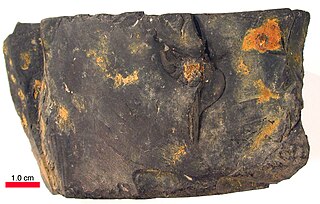
Coal oil is a shale oil obtained from the destructive distillation of cannel coal, mineral wax, or bituminous shale, once used widely for illumination.

The Geordie lamp was a safety lamp for use in flammable atmospheres, invented by George Stephenson in 1815 as a miner's lamp to prevent explosions due to firedamp in coal mines.

Sewer gas is a complex, generally obnoxious smelling mixture of toxic and nontoxic gases produced and collected in sewage systems by the decomposition of organic household or industrial wastes, typical components of sewage.
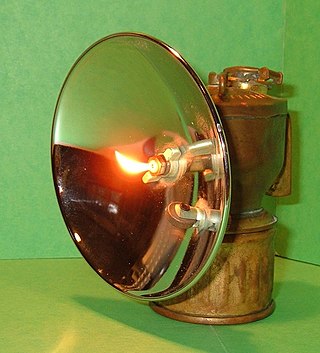
A Carbide lamp or acetylene gas lamp is a simple lamp that produces and burns acetylene (C2H2), which is created by the reaction of calcium carbide (CaC2) with water (H2O).
A safety lamp is any of several types of lamp that provides illumination in places such as coal mines where the air may carry coal dust or a build-up of inflammable gases, which may explode if ignited, possibly by an electric spark. Until the development of effective electric lamps in the early 1900s, miners used flame lamps to provide illumination. Open flame lamps could ignite flammable gases which collected in mines, causing explosions; safety lamps were developed to enclose the flame to prevent it from igniting the explosive gases. Flame safety lamps have been replaced for lighting in mining with sealed explosion-proof electric lights, but continue to be used to detect gases.
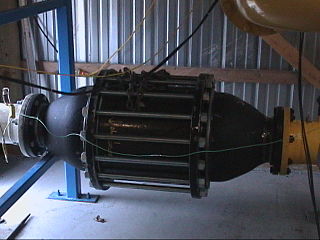
A flame arrester, deflagration arrester, or flame trap is a device or form of construction that will allow free passage of a gas or gaseous mixture but will interrupt or prevent the passage of flame. It prevents the transmission of flame through a flammable gas/air mixture by quenching the flame on the high surface area provided by an array of small passages through which the flame must pass. The emerging gases are cooled enough to prevent ignition on the protected side.
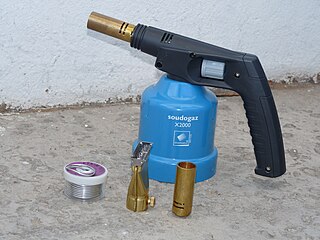
A blowtorch, also referred to as a blowlamp, is an ambient air fuel-burning gas lamp used for applying flame and heat to various applications, usually metalworking.